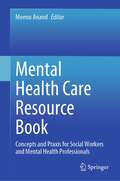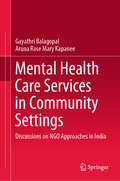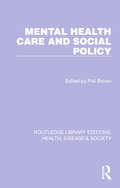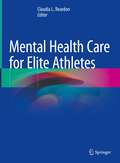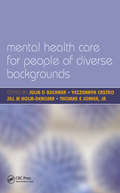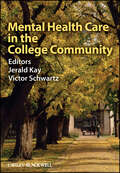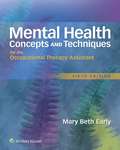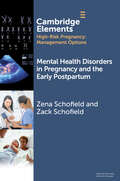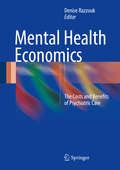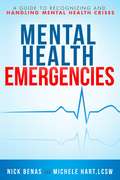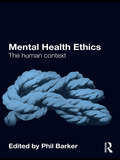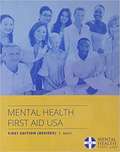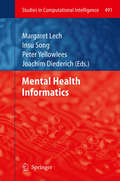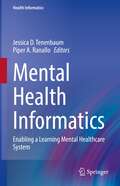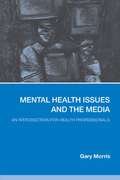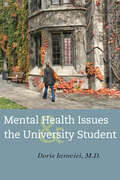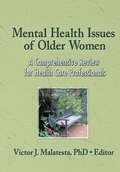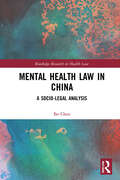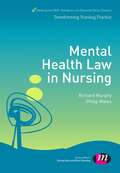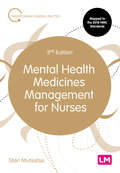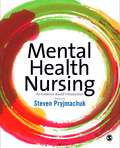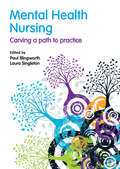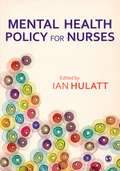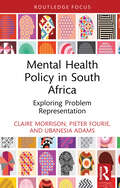- Table View
- List View
Mental Health Care Resource Book: Concepts and Praxis for Social Workers and Mental Health Professionals
by Meenu AnandThis book takes a strengths-based approach to focus on different aspects of mental health. It summarizes the complex intertwining of illness and culture in the context of rising cases of mental disorders in the post-pandemic world. The book contains three sections, each incorporating essential skills and praxis. The book's first section examines the fundamental and conceptual underpinnings of mental health, well-being, and wellness from an eclectic lens to present an overview of mental health from the biopsychosocial perspective. The second section demonstrates using and transforming theoretical principles and perspectives into practice-based skills through detailed narrations and illustrations. It also showcases how to apply these skills in real-world settings. The third and final section combines field-based narratives that reflect multifaceted challenges and efforts toward treating mental disorders and promoting positive mental health, including success stories in diverse settings.This section highlights the importance of praxis in mental health. The book is a valuable resource for scholars and professionals in various fields, such as social work, psychology, sociology, social psychiatry, gender studies, and anyone interested in learning more about mental health and well-being.
Mental Health Care Services in Community Settings: Discussions on NGO Approaches in India
by Gayathri Balagopal Aruna Rose KapaneeThis book discusses approaches used by NGOs in formulating and implementing mental health care in the community in the context of high treatment gap, insufficient public expenditure on health, human resource shortages, heterogeneity of communities as well as cultural beliefs in India. It uses a qualitative case study approach to document and analyse the work of some major NGO-run community mental health programmes in India, all of which cater to vulnerable populations and are in different and diverse regional settings. It casts the spotlight on envisioning community mental health in policy and law, implementation by the government, how it is practised by select NGOs and the challenges involved in programme implementation. In doing so, it hopes to understand the trigger factors that have led to NGOs embarking on community mental health programmes: how needs of the community are understood, the funding mechanisms, how the human resource gap was addressed, type of networks formed in the community, therapeutic and social interventions, accountability mechanisms, achievements and limitations of the programmes. This book is for students and researchers in the fields of social work and psychology, and NGOs, government and funding agencies, and for those interested in understanding and working with community mental health programmes.
Mental Health Care and Social Policy (Routledge Library Editions: Health, Disease and Society #6)
by Phil BrownOriginally published in 1985, at a time when the previous 2 decades had witnessed dramatic changes in the US mental health system. These included the decline of the state mental hospital, the birth of the community mental health center and the expansion of psychiatric services in general hospitals. The inevitable results of the changes were the creation of a huge nursing home population of the chronically mentally ill, and the multiplication of urban ‘street people’. Mental health care is uncoordinated and underfunded. The historical roots of these problems are examined in this book which is designed both as a professional reference volume and as a text for students in the sociology of mental health and illness. The contributors are drawn from diverse fields, including sociology, psychiatry, psychology, epidemiology and social history.
Mental Health Care for Elite Athletes
by Claudia L. ReardonThis book examines the nuances and specifications of mental health in elite athletes. It meets the market need for a reference that utilizes a narrow scope to focus on the unique nature of this demographic’s mental health. It enriches the understanding and appreciation of mental health symptoms and disorders in elite athletes and thus the ability to appropriately address those issues. The book first addresses the essential topics necessary for an authoritative resource on mental health, such as general mental health disorder symptoms, diagnoses, and treatment. Subsequent chapters then dive into the very specific issues affecting elite athletes, including the adverse effects of overtraining, sports-related concussions, behavioral addictions, and psychological responses to injury and illness. Closing chapters then analyze mental health disorders and issues specific to diverse demographics such as youth athletes, Paralympic athletes, and athletes of various ethnic and religious backgrounds. Timely and essential, Mental Health Care for Elite Athletes is an invaluable reference for a variety of healthcare professionals who work with elite athletes and interested non-medical members of the athlete entourage, such as coaches and family.
Mental Health Care for People of Diverse Backgrounds: The Epidemiologically Based Needs Assessment Reviews, Vol 1
by Norman Ellis Julia D. Buckner Yezzennya CastroMental health care needs vary in different groups of people, but many healthcare professionals have a poor understanding of exactly how. From ethnicity to sexuality, family to religion, "Mental Health Care for People of Diverse Backgrounds" is a unique examination of how cultures can, and should, influence psychological services. It presents both theoretical and practical information regarding assessment, diagnosis and treatment. Concentrating on empirically based treatments, the book fuses clinical experience and research to give a wide-ranging overview. It also features many illuminating case studies. It is an invaluable reference for all mental healthcare professionals including psychologists, psychiatrists, doctors, social workers, nurses and counsellors, as well as students and academics with an interest in mental healthcare. "The information contained in these chapters is intended for individuals with many levels of clinical training and is therefore appropriate for trainees in psychology and psychiatry, as well as experienced mental health providers. The chapters in this book contain information relevant to assessment, diagnosis, and treatment of individuals from diverse populations." - Julia D Buckner, Yezzennya Castro, Jill M Holm-Denoma and Thomas E Joiner Jr.
Mental Health Care in the College Community
by Jerald Kay Victor SchwartzMental health concerns are the most serious and prevalent health problems among students in higher education. Increasingly effective psychopharmacological and psychotherapeutic treatments have facilitated matriculation for students with histories of anxiety, mood, personality, eating and substance abuse disorders. This phenomenon has been accompanied by a striking increase in the number of previously undiagnosed students requesting treatment. College and university mental health programs struggle to care for larger numbers of students, necessitating greater interdisciplinary collaboration in treatment, research, outreach, and educational services.This book fills an important gap in the literature and provides a comprehensive resource for nearly every aspect of college mental health. It includes a strong emphasis on the training and education of graduate and professional students for future work in this field. Chapters are devoted to the significant ethical and legal issues related to treatment and associated administrative and policy challenges. Scholarly chapters on the promise of community mental health and public health approaches are especially innovative. There is also a chapter on international issues in college mental health which will be helpful to those students studying abroad. Mental Health Care in the College Community is written by acknowledged experts from mental health, college and university administration, legal and educational disciplines, all with extensive administrative and clinical experience in higher education settings. This book is clearly written and well illustrated with abundant tables, charts, and figures.This text will become essential reading for college mental health clinicians, graduate students in the mental health disciplines (psychiatry, psychology, counselling, nursing, and social work), student affairs deans and their staff, and even presidents or provosts of universities and colleges.
Mental Health Concepts and Techniques for the Occupational Therapy Assistant
by Mary Beth EarlyThis updated 5th Edition of Mary Beth Early's best-seller remains the only resource specifically developed to prepare occupational therapy assistant students to work effectively with clients with mental health issues across all practice settings. <P><P> Filled with up-to-date, evidence-based practice information and examples of contemporary interventions, Mental Health Concepts and Techniques for the Occupational Therapy Assistant helps students develop a sound foundation in occupational therapy processes and illustrates how to intervene effectively to meet the needs of clients with mental health issues. <P><P> The 5th Edition reflects the latest professional standards and recent developments in the field and includes new content, new pedagogy, and new online resources to save instructors time and help students succeed.
Mental Health Disorders in Pregnancy and the Early Postpartum (Elements in High Risk Pregnancy: Management Options)
by Zena Schofield Zack SchofieldMental health disorders are common in pregnancy and after childbirth with over 10% of women manifesting some form of mental illness during this time. Maternity services will encounter women with symptoms that vary in severity from mild self-limiting to potentially life-threatening. These conditions carry risks for both the woman and the fetus/newborn. Detecting women with, or at risk of, a serious mental health disorder and enabling them to access appropriate care in a timely fashion is a shared responsibility. However, given the frequency of contact they have with women through this period, maternity services have a pivotal role. From a mental health perspective, high-risk pregnancies are those primarily associated with serious mental illness (psychotic illnesses, bipolar disorder and severe depressive episodes). Healthcare professionals caring for pregnant women should have the appropriate skills to detect serious mental illness and identify women at risk and how to access specialist mental health care.
Mental Health Economics
by Denise RazzoukThe main objective of this work is to provide a book with high quality content that becomes a reference and support for graduate course (Mental Health, Public Health and Epidemiology) and for research in the domain of health economics applied to mental health. Also this book might be useful for policymakers on formulating mental health policies. Key messages of this book are based on: a) mental illness represent a huge cost for society and for health care; b) health economics applied to mental health could help in the optimization of resource allocation for mental health care and for better decision making in terms of balancing costs and benefits; c) interventions and treatment should be also chosen in general medical practice and in public decision-policy according to cost-effectiveness, burden of disease and equity principles; d) quality of care is related with better outcomes, higher quality of life for clients, and with lower costs for society and health system (best value for money); e) it is possible to decrease the burden of mental disorders with cost-effective treatments. The book is divided in four main topics: 1. Introduction to Health Economics applied to Mental Health - this section is an overview of basic principles, concepts and methods used in Economics and Health Economics to enable students to make critical appraisal of Health Economics texts and also to design research studies in this topic. 2. Health Economics applied to the evaluation of quality and costs of Mental Health Services - this section presents results of Brazilian studies on the costs of mental health care (hospital, outpatient care, residential care, informal care), methods on the measurement of costs and it discusses issues related with public policies decisions and quality of mental health car in the low and middle income countries context. There is also an overview of quality indicators of mental health care and instruments to evaluate mental health services and costs. 3. Health Economics applied to evaluate treatment of mental disorders - This section presents a review of cost-effectiveness of pharmacological treatments and other interventions applied for treating the most burdensome mental disorders such as depressive and anxiety disorders, bipolar disorders, psychosis, alcohol and drug disorders, dementia, and hyper attention deficit disorders. 4. Health Economics, burden and indirect costs of mental disorders - This section highlights the social and economic burden caused by mental illness under societal perspective focusing on stigma, unemployment, indirect costs in the workplace (absenteeism and presenteeism), the relationship between poverty and mental disorders, global health and social determinants of mental health and on the costs of mental disorders (depression, anxiety, psychosis, alcohol and drug disorders). We present some instruments to measure indirect costs of mental disorders.
Mental Health Emergencies: A Guide to Recognizing and Handling Mental Health Crises
by Michele Hart Nick BenasDrawn from the best in psychiatry, psychology, and mental health counseling, here are simple and effective strategies for coping during times of great mental and emotional distress Mental Health Emergencies provides overviews and expert guidance on serious mental health problems. It is an ideal resource for first-responders, teachers, counselors, and human resource professionals looking to help those struggling with mental and emotional health crises and concerns. Developed from best practices of psychiatry, psychology, and mental health counseling, Mental Health Emergencies is a guide to providing much-needed care and support to the people in distress who most need help including self-injury, eating disorders, substance abuse, psychosis, and suicidal thoughts. Mental Health Emergencies will help you provide exactly the right kind of support—where and when it's needed most.
Mental Health Ethics: The Human Context
by Phil BarkerAll human behaviour is, ultimately, a moral undertaking, in which each situation must be considered on its own merits. As a result ethical conduct is complex. Despite the proliferation of Codes of Conduct and other forms of professional guidance, there are no easy answers to most human problems. Mental Health Ethics encourages readers to heighten their awareness of the key ethical dilemmas found in mainstream contemporary mental health practice. This text provides an overview of traditional and contemporary ethical perspectives and critically examines a range of ethical and moral challenges present in contemporary ‘psychiatric-mental’ health services. Offering a comprehensive and interdisciplinary perspective, it includes six parts, each with their own introduction, summary and set of ethical challenges, covering: fundamental ethical principles; legal issues; specific challenges for different professional groups; working with different service user groups; models of care and treatment; recovery and human rights perspectives. Providing detailed consideration of issues and dilemmas, Mental Health Ethics helps all mental health professionals keep people at the centre of the services they offer.
Mental Health First Aid USA: First Edition (Revised)
by Mental Health First Aid StaffFrom the "about this manual" section at the beginning of the book: "This revised first edition was produced for the purposes of improving mental health knowledge and skills of the U.S. public in responding to early-stage mental illnesses and mental health crises. The course information is most relevant in situations where it becomes apparent to others that persons in their social network are developing serious mental health problems. However, the course may also provide useful information on how to assist a person who has a history of a mental disorder or longer-term mental health problems."
Mental Health Informatics
by Insu Song Margaret Lech Peter Yellowlees Joachim DiederichThis book introduces approaches that have the potential to transform the daily practice of psychiatrists and psychologists. This includes the asynchronous communication between mental health care providers and clients as well as the automation of assessment and therapy. Speech and language are particularly interesting from the viewpoint of psychological assessment. For instance, depression may change the characteristics of voice in individuals and these changes can be detected by a special form of speech analysis. Computational screening methods that utilize speech and language can detect subtle changes and alert clinicians as well as individuals and caregivers. The use of online technologies in mental health, however, poses ethical problems that will occupy concerned individuals, governments and the wider public for some time. Assuming that these ethical problems can be solved, it should be possible to diagnose and treat mental health disorders online (excluding the use of medication). Speech and language are particularly interesting from the viewpoint of psychological assessment. For instance, depression may change the characteristics of voice in individuals and these changes can be detected by a special form of speech analysis. Computational screening methods that utilize speech and language can detect subtle changes and alert clinicians as well as individuals and caregivers. The use of online technologies in mental health, however, poses ethical problems that will occupy concerned individuals, governments and the wider public for some time. Assuming that these ethical problems can be solved, it should be possible to diagnose and treat mental health disorders online (excluding the use of medication).
Mental Health Informatics: Enabling a Learning Mental Healthcare System (Health Informatics)
by Jessica D. Tenenbaum Piper A. RanalloThis textbook provides a detailed resource introducing the subdiscipline of mental health informatics. It systematically reviews the methods, paradigms, tools and knowledge base in both clinical and bioinformatics and across the spectrum from research to clinical care. Key foundational technologies, such as terminologies, ontologies and data exchange standards are presented and given context within the complex landscape of mental health conditions, research and care. The learning health system model is utilized to emphasize the bi-directional nature of the translational science associated with mental health processes. Descriptions of the data, technologies, paradigms and products that are generated by and used in each process and their limitations are discussed. Mental Health Informatics: Enabling a Learning Mental Healthcare System is a comprehensive introductory resource for students, educators and researchers in mental health informatics and related behavioral sciences. It is an ideal resource for use in a survey course for both pre- and post-doctoral training programs, as well as for healthcare administrators, funding entities, vendors and product developers working to make mental healthcare more evidence-based.
Mental Health Issues and the Media: An Introduction for Health Professionals
by Gary MorrisMental Health Issues and the Media provides students and professionals in nursing and allied professions, in psychiatry, psychology and related disciplines, with a theoretically grounded introduction to the ways in which our attitudes are shaped by the media. A wide range of contemporary media help to create attitudes surrounding mental health and illness, and for all health professionals, the ways in which they do so are of immediate concern. Health professionals need to: be aware of media influences on their own perceptions and attitudes take account of both the negative and positive aspects of media intervention in mental health promotion and public education understand the way in which we all interact with media messages and how this affects both practitioners and service users. Covering the press, literature, film, television and the Internet, this comprehensive text includes practical advice and recommendations on how to combat negative images for service users, healthcare workers and media personnel.
Mental Health Issues and the University Student
by Doris IaroviciCase-based intervention strategies for mental health professionals working with college and university students.Young adults enter college with many challenges—complicated family dynamics, identity issues, and extreme pressure to succeed, among others. Students may also have mental health difficulties, ranging from adjustment disorders to mood disorders, and growing numbers of them are seeking help on campus.But these students are also resilient and eager to learn, stepping onto campus with hope for a new and better phase of life. Doris Iarovici, a psychiatrist at Duke University Counseling and Psychological Services, sees in college and university mental health services an opportunity for mental health professionals to bring about positive change with young people during a crucial period of their development. Dr. Iarovici describes the current college mental health crisis and narrates how college mental health services have evolved along with changes in student populations. She discusses students’ lifestyle problems and psychiatric concerns, using case vignettes to explore a variety of interventions. Included are discussions of substance abuse, relationship difficulties, eating disorders, depression and anxiety, and culture clashes. Problems uniquely addressed in this book include sleep disturbances and perfectionism. An essential component of the volume is a guide to making emergency assessments, from risk classification and hospitalization to public safety and communication within and outside the campus community.
Mental Health Issues of Older Women: A Comprehensive Review for Health Care Professionals
by Victor J. MalatestaDiscover the latest research on the mental health concerns of older womenWomen are the primary consumers of mental health services, however, there is a paucity of research on their specific needs. Mental Health Issues of Older Women: A Comprehensive Review for Health Care Professionals presents a comprehensive overview for health care professionals, educators, and students on the study of mental health problems of aging women. This resource provides the latest research and informed perspectives by seasoned mental health clinicians. A wide range of mental health problems are explored, including dementia, cognitive impairment, alcohol abuse, schizophrenia, depression and anxiety disorders, traumatic and dissociative disorders, sexual and eating disorders, and personality disorders.Mental Health Issues of Older Women provides practicing therapists and counselors with a much-needed research update and a broad clinical perspective from respected experts. This book uses current psychiatric diagnoses as a framework to gain greater depth of understanding to address the mental health issues of older women. Students and health professionals will discover valuable information, inspiration, and encouragement in their work with middle-aged and older women who are facing mental health challenges. This volume provides extensive references.Topics in Mental Health Issues of Older Women include: the role of cognitive impairment in older persons assessment tools and treatment options for older women who display alcohol use problems schizophrenia in older women major depressive disorder among older women therapeutic options for anxiety disorders under-diagnosed and misdiagnosed incidents of PTSD a provocative look at dissociative identity disorder sexual problems with treatment options eating disorders with treatment approaches effective treatment options for borderline personality disorderMental Health Issues of Older Women provides practitioners, educators, students, researchers, and administrators with an essential review of the latest research and current issues on the mental health problems of older women.
Mental Health Law in China: A Socio-legal Analysis (Routledge Research in Health Law)
by Bo ChenThis book provides an important critique of mental health law and practice in China, with a focus on involuntary detention and treatment. The work explores China’s mental health law reform regarding treatment decision-making in the new era of the UN Convention on the Rights of Persons with Disabilities (CRPD). It adopts a socio-legal approach, not only by undertaking a comprehensive desk-based analysis of the reforms introduced by China’s Mental Health Law (MHL) but also examining its implementation based on evidence from practice. The book seeks to investigate whether China’s first national MHL takes a step closer to the requirements of the UN Convention on the Rights of Persons with Disabilities on mental health treatment decision-making, and, if not, why not? The book will be of interest to those working in the areas of mental health law and policy, medical law and disability, human rights law, and Asian Studies.
Mental Health Law in Nursing (Transforming Nursing Practice)
by Richard Murphy Philip WalesMental health nursing students need to understand their legal duties towards all clients, including specific laws for care of detained patients. Yet these laws can be comples, confusing, and difficult to relate to the reality of nursing care. This book is a clear guide to the Mental Health Act and Code of Practice which explains the specific duties, responsibilities and powers of mental health nurses and the care of detained patients in particular. It explains the most frequently encountered parts of the Act and Code and clarifies common misunderstandings. It outlines dilemmas faced by nurses which may arise from possible conflicting responsibilities. It also gives an introduction to other major legal considerations that mental health nursing students need. Key features: Specific guide to the law for mental health nursing students, written by experienced practitioners involved in MHA regulation in England Case studies and examples help the reader relate the law to their clinical practice Multiple choice questions and acticvities help students to develop confidence and become critical and independent learners Linked to relevant NMC Standards and ESCs for degree-level education.
Mental Health Medicines Management for Nurses (Transforming Nursing Practice Series)
by Stanley MutsatsaMental Health Medicines Management for Nurses provides nursing students with guidance on how to manage medicines safely and effectively when treating patients with mental health conditions. It outlines how psychiatric drugs work, what the common treatments are, the ethical, legal, and person-centred aspects of working with psychiatric medicines, and how medicines can and should be used in mental health care. Using innovative activities and real-life case studies, this book has been carefully designed to be the ideal resource to build knowledge and confidence in this important area of practice. Key features: Updated in-line with the latest NMC standards of proficiency for registered nurses. Includes clear explanations of both the underlying biology and pharmacology as well as the wider practicalities of working with medicines. Highlights the most common mental health conditions and associated treatments, including coverage of the possible side effects for all drugs described in the book. NEW: Increased emphasis on prescribing with new content on consultation, history taking, and decision-making when prescribing. NEW: Updated sections on ethics, consent, pharmacokinetics, antipsychotics, and adverse drug reactions.
Mental Health Medicines Management for Nurses (Transforming Nursing Practice Series)
by Stanley MutsatsaMental Health Medicines Management for Nurses provides nursing students with guidance on how to manage medicines safely and effectively when treating patients with mental health conditions. It outlines how psychiatric drugs work, what the common treatments are, the ethical, legal, and person-centred aspects of working with psychiatric medicines, and how medicines can and should be used in mental health care. Using innovative activities and real-life case studies, this book has been carefully designed to be the ideal resource to build knowledge and confidence in this important area of practice. Key features: Updated in-line with the latest NMC standards of proficiency for registered nurses. Includes clear explanations of both the underlying biology and pharmacology as well as the wider practicalities of working with medicines. Highlights the most common mental health conditions and associated treatments, including coverage of the possible side effects for all drugs described in the book. NEW: Increased emphasis on prescribing with new content on consultation, history taking, and decision-making when prescribing. NEW: Updated sections on ethics, consent, pharmacokinetics, antipsychotics, and adverse drug reactions.
Mental Health Nursing: An Evidence Based Introduction
by Steven PryjmachukDo you want to know how to help people with mental health problems? This book introduces you to the core skills and essential knowledge you need to deliver high-quality care. Mental Health Nursing is a practical, values- and evidence-based resource which will guide and support you through your pre-registration mental health nursing programme and into your own practice. Dedicated chapters focus on the major mental health problems, and are clearly structured so that you can quickly and easily identify what you want learn about helping people with, for example, depression, anxiety, psychosis, or acute mental health problems. The most up-to-date theories, as well as mental health policies and law from all four countries of the UK, are explained accessibly by experienced lecturers and nurse practitioners who show you through real-life case scenarios how you can use your newly-acquired knowledge and skills to deliver high-quality care yourself. You will also be encouraged - through regular reflection and discussion points - to see things with a critical eye and to engage in and drive on the debates that make mental health nursing such an exciting field to be studying and working in. Set within a framework which emphasises and makes clear the core skills, values and knowledge-base you need to become capable mental health nurse, you will find this book a vital companion as you progress through your studies and onto helping people confidently in everyday life.
Mental Health Nursing: carving a path to practice
by Paul Illingworth Laura SingletonAre you wondering if a career in Mental Health Nursing is right for you? If you are considering studying Mental Health Nursing or have already begun your course this book is the perfect tool to see if you have what it takes to be a Mental Health Nurse. It will tell you what to expect in your studies and address the ups and the downs of becoming a Mental Health nurse. It contains personal anecdotes from students who have already completed their course and advice from Mental Health lecturers on how to get the most out of your studies. This book will guide you through your course from beginning to end and prepare you for your future career.
Mental Health Policy for Nurses
by Ian HulattMental health nursing has been shaped by a variety of policy factors in the past 50 years. In this new textbook, edited by the mental health policy advisor to the Royal College of Nursing, a range of experts in their field introduce the essential elements of policy and legislation to new students and experienced practitioners which will affect them throughout their careers. Clinical examples are drawn on throughout, to help students think about the real-life context of what can be a difficult subject.
Mental Health Policy in South Africa: Exploring Problem Representation (Routledge Studies in Health in Africa)
by Pieter Fourie Claire Morrison Ubanesia AdamsThis book investigates how mental health in South Africa is conceptualised and constructed in public policy. Critiquing embedded assumptions within existing policy documentation, the book advocates for policy solutions centred on poverty alleviation and economic development.Mental health in South Africa has historically been neglected within the health-care system, a stark reality underscored by the Life Esidimeni tragedy, which exposed widespread mismanagement, negligence, and insufficient resources in mental health-care services. While South Africa has enacted progressive mental health policies, their effective implementation remains hindered by systemic challenges. This book investigates the dominant problems represented in mental health policies, including the segregation of mental health from general health services, inadequate intersectoral collaboration in mental health care, community disconnection from mental health services, the association between poverty and mental health issues, and infringements upon the rights of individuals with mental health problems. Overall, the book underscores mental health as a socio-economic issue, requiring new policy solutions.This book will be an essential read for mental health professionals and policy makers in South Africa, as well as for researchers working on the good governance of mental health, both within the country and at global and multilateral levels.
